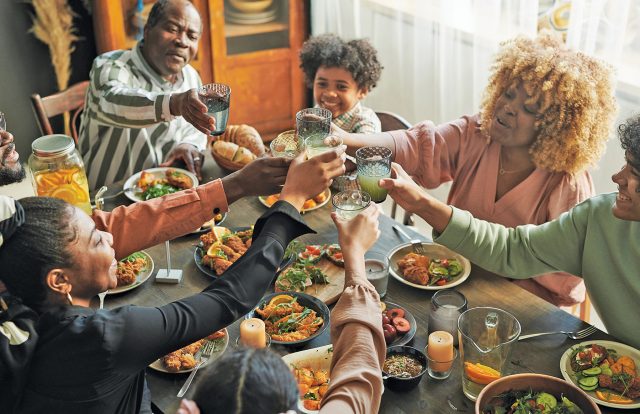Catherine Boeckmann
www.almanac.com
The United States celebrates Thanksgiving as a national holiday on the fourth Thursday in November. In 2023, Thanksgiving will be observed on Thursday, November 23.
Thanksgiving has been held on the fourth Thursday in November since 1941, which means that the actual date of the holiday shifts each year. The earliest Thanksgiving can occur is November 22; the latest is November 28.
President Roosevelt changed Thanksgiving from the fourth Thursday to the third Thursday in November in 1938. However, this was not a very popular move.
Thanksgiving Becomes a National Holiday
The first national celebration of Thanksgiving was observed in honor of the creation of the new United States Constitution! In 1789, President George Washington issued a proclamation designating November 26 of that year as a ”Day of Publick Thanksgivin” to recognize the role of providence in creating the new United States and the new federal Constitution.
Washington was in his first term as president, and a young nation had just emerged successfully from the Revolution. Washington called on the people of the United States to acknowledge God for affording them “an opportunity peaceably to establish a form of government for their safety and happiness.” This was the first time Thanksgiving was celebrated under the new Constitution.
Thanksgiving Becomes a Federal Holiday
While Thanksgiving became a yearly tradition in many communities—celebrated on different months and days that suited them—it was not yet a federal government holiday.
Thomas Jefferson and many subsequent presidents felt that a public religious demonstration of piety was not appropriate for a government type of holiday in a country based in part on the separation of church and state. While religious Thanksgiving services continued, no further presidential proclamations marked Thanksgiving until the Civil War of the 1860s.
It wasn’t until 1863, during the Civil War, that President Abraham Lincoln proclaimed a national Thanksgiving Day to be held each November.
Thanksgiving is briefly moved to the third Thursday in November
In 1939, President Franklin D. Roosevelt changed Thanksgiving from the last Thursday in November to the second to the last Thursday. It was the tail-end of the Depression, and Roosevelt’s goal was to create more shopping days before Christmas and to give the economy a boost. However, many people continued to celebrate Thanksgiving on the last Thursday in November, unhappy that the holiday’s date had been meddled with. You could argue, however, that this helped create the shopping craze known as Black Friday.
In 1941, to end any confusion, the president and Congress established Thanksgiving as a United States federal holiday to be celebrated on the fourth Thursday in November, which is how it stands today!
Of course, Thanksgiving was not born of presidential proclamations. Read about Sarah Josepha Hale, the “Godmother of Thanksgiving,” who helped turn this historic feast into a national holiday.
Today, folks celebrate Thanksgiving for a multitude of reasons. For some, it remains a way to express gratitude for the harvest, for family, or to a higher power; for others, it’s a holiday built upon simply being united as a family (in person or virtually!) and sharing in a special meal.
A bountiful feast featuring turkey has become the traditional Thanksgiving fare, with over 90 percent of Americans eating the bird on this holiday. But did you know that turkey was at one time a rare treat? During the 1830s, an eight- to ten-pound bird cost a day’s wages!
Even though turkeys are much more affordable today, they remain a celebratory symbol of bounty. In fact, astronauts Neil Armstrong and Edwin Aldrin ate roast turkey in foil packets for their first meal on the Moon. Do you think they had mashed potatoes and cranberry sauce?
Other common Thanksgiving traditions in the United States include volunteering for those less fortunate by donating food or time to homeless shelters or those in need. Sometimes, communities hold “turkey trot” runs or parades. And the president of the United States and a number of U.S. governors will often “pardon” one or two Thanksgiving turkeys each year.
Thanksgiving Weather Folklore
- Turkeys perched on trees and refusing to descend indicates snow.
- If the first snow sticks to the trees, it foretells a bountiful harvest in the coming year.
- If sheep feed facing downhill, watch for a snowstorm.
- Thunder in November indicates a fertile year to come.
- If there be ice in November that will bear a duck, there will be nothing thereafter but sleet and muck.
- As November 21st, so the winter.
- When the winter is early, it will not be late.
- The term “Indian summer” refers to a period of warm weather occurring between November 11 and 20.
Thanksgiving Poems and Quotes
Perhaps these poems and quotes will come in handy for your Thanksgiving card!
Ah! On Thanksgiving Day, when from East and from West,
From North and from South, come the pilgrim and guest,
What moistens the lip, and what brightens the eye?
What calls back the past like the rich pumpkin pie?
–J. G. Whittier
Over the river and through the wood—
Now grandmother’s cap I spy!
Hurrah for the fun!
Is the pudding done?
Hurrah for the pumpkin-pie!
–Lydia Maria Child
Orchards have shared their treasures,
The fields, their yellow grain,
So open wide the doorway—
Thanksgiving comes again!
–Unknown
“An optimist is a person who starts a new diet on Thanksgiving Day.” –Irv Kupcinet, American columnist (1912–2003)
“Radical historians now tell the story of Thanksgiving from the point of view of the turkey.” –Mason Cooley, U.S. aphorist





